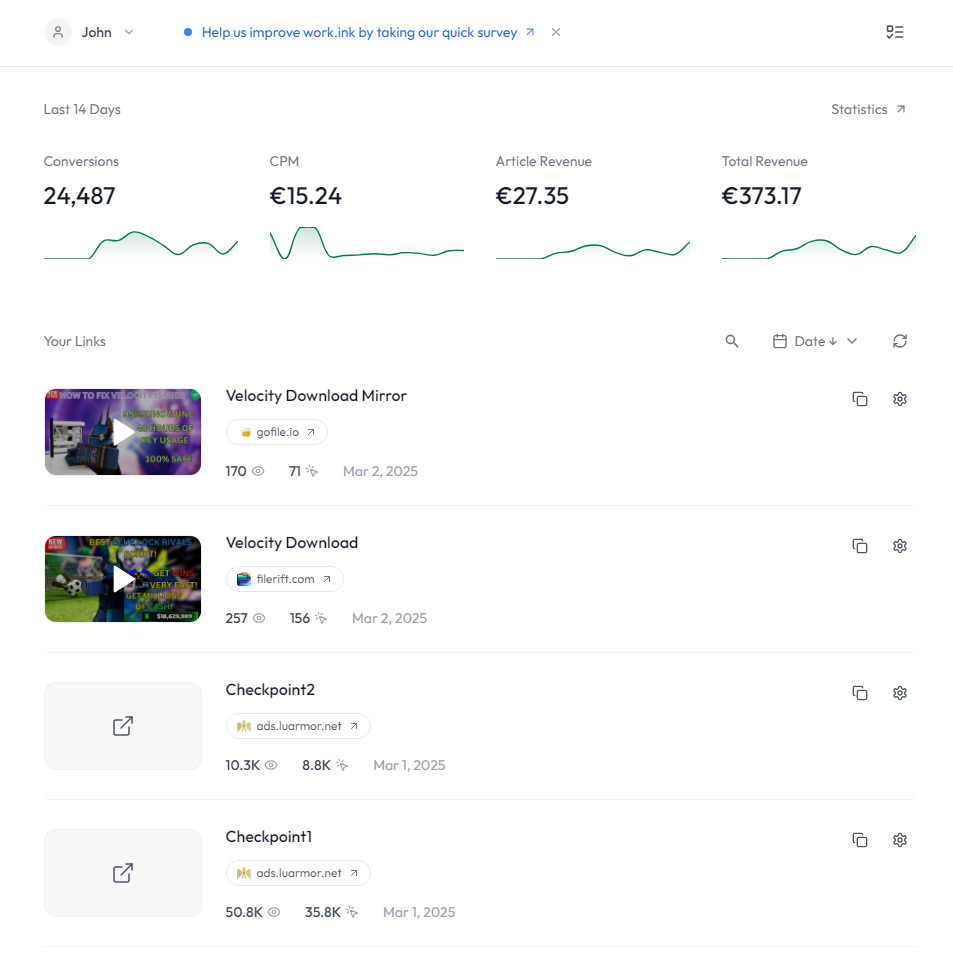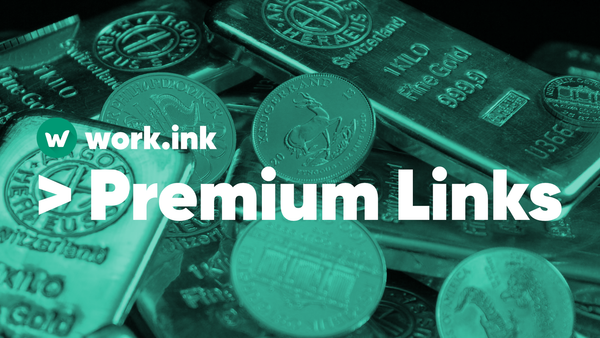How to Make Money Online in 2025: Legitimate Side Hustles and Passive Income Ideas

Many people are exploring side hustles and online income streams from home. In 2025, the landscape of making money online offers more opportunities than ever. Whether you’re looking for a side hustle to supplement your 9-to-5 or aiming to build passive income streams, it’s crucial to focus on legitimate methods and set realistic expectations. In fact, about one-third of Americans engaged in a side gig in 2024, with popular options ranging from freelancing to selling products online. The key is to leverage your skills and time effectively, avoid get-rich-quick traps, and diversify your approach. This article will walk you through practical ways to earn money from home – including freelancing, affiliate marketing, selling digital products, taking online surveys, and doing microtasks – and show how tools like Work.ink (a high-paying URL shortener) can boost your online income. Each method comes with actionable tips to help you get started without over-promising on results.
Freelancing: Turn Your Skills into Income
Freelancing is one of the most popular ways to make money online in 2025. It allows you to offer services (writing, graphic design, programming, marketing, etc.) to clients on a flexible, per-project basis. This can be a lucrative side hustle or even a full-time career if you build a strong reputation. The demand is huge – on Upwork (one of the largest freelance marketplaces), businesses spent over $4.1 billion on freelance work in 2023 across more than 125 job categories.
From small startups to large companies, millions of clients are looking to hire freelancers for remote work.
How to succeed in freelancing: Start by identifying your marketable skills and creating a portfolio of your best work. Join reputable freelance platforms like Upwork, Fiverr, or Freelancer.com and set up a profile that highlights your expertise. Here are some actionable tips to kickstart your freelance side hustle:
- Build a Strong Portfolio: If you’re new, do a few small jobs (even if the pay is low) to get positive reviews and work examples. A solid portfolio instills confidence in potential clients.
- Choose a Niche: Specializing in a niche (e.g. SEO content writing or mobile app UI design) can help you stand out in a crowded marketplace. Clients often prefer specialists for important tasks.
- Set Realistic Rates: Research what others in your field charge. As a beginner, you may start with competitive rates to win clients, then gradually increase your fees as you gain experience and positive reviews.
- Deliver Quality & Communicate: Treat every project professionally. Meet deadlines, communicate clearly, and exceed expectations. Satisfied clients can lead to repeat business or referrals – a big plus in building your income.
- Use Trusted Platforms: Freelance platforms escrow payments and offer some protection against scams. Avoid off-platform deals early on. As you gain experience, you can also pitch clients directly and use contracts for safety.
Freelancing lets you directly convert your skills into cash. It’s often active income (you get paid per project or hour), but over time you can develop recurring clients or even sell retainer services for more stable income. Always remember, freelancing is a business – the more you market yourself and deliver value, the more you can earn. Many people start it as a side hustle and eventually grow it into a full-time work-from-home career.
Affiliate Marketing: Earn Passive Income by Promoting Products
Affiliate marketing is a popular online earning strategy, especially attractive because of its passive income potential. In affiliate marketing, you earn commissions by recommending or promoting products and services to others via special referral links. Whenever someone makes a purchase (or performs a required action) through your affiliate link, you get a percentage of the sale or a fixed bounty. This model can become a passive income stream – for example, a blog post or YouTube video you created last year could still be generating commissions today if it continues to attract viewers.
To succeed in affiliate marketing, you typically need a platform where you can share content and links: a blog, a YouTube channel, a popular social media account, or even an email newsletter. The idea is to create valuable content that attracts an audience interested in a particular niche (such as tech gadgets, fitness, or fashion) and then recommend relevant products. The scale of affiliate marketing is immense – it’s projected to hit $37.3 billion globally by 2025, with over 80% of brands running affiliate programs. This means there are thousands of companies (Amazon, eBay, ClickBank, and niche-specific merchants) offering referral commissions to marketers.

Affiliate marketers often use analytics to track traffic and conversions. Here are practical steps to get started with affiliate marketing as an online side hustle:
- Pick a Niche and Platform: Choose a topic area you are knowledgeable or passionate about – e.g. home fitness, vegan cooking, personal finance – and a platform to publish content (blog/website, YouTube videos, Instagram, etc.). It’s easier to build an audience and trust when you focus on a niche.
- Join Affiliate Programs: Sign up for affiliate networks or programs relevant to your niche. Large networks like Amazon Associates, ShareASale, CJ Affiliate, or niche-specific programs (for instance, a web hosting company’s affiliate program if you run a tech blog) are good places to start. These networks provide you with trackable links or discount codes.
- Create Valuable Content: Produce content that naturally allows you to recommend your affiliate products. For example, write a “Top 10” review of products, do tutorial videos, or share your personal experiences. The content should be honest, engaging, and actually helpful – this builds credibility with your audience.
- Drive Traffic (SEO and Social Media): Employ basic SEO (search engine optimization) tactics so that people can find your content via Google. Promote your content on social media and online communities. The more targeted traffic you get, the higher the chance someone will click your affiliate links.
- Be Transparent: Always disclose that your links are affiliate links (this is both an ethical practice and a legal requirement in many jurisdictions). Audiences appreciate honesty – a simple note like “This post contains affiliate links; I may earn a commission if you purchase through them at no extra cost to you.” goes a long way in maintaining trust.
- Optimize and Scale: Use analytics to see which content or links get the most clicks and conversions. For example, track which product reviews are earning the most. Focus on creating more content like that. Over time, you can update old posts, improve your calls-to-action, or experiment with different products to increase your earnings.
Affiliate marketing can indeed become a form of passive income. Once your content is online, it can keep attracting visitors and generating commissions with minimal ongoing effort – even while you sleep. However, it’s not a get-rich-quick scheme: it requires upfront work to produce quality content and build an audience. Keep your expectations realistic (for instance, conversion rates around 1% are common in many niches, so you might need hundreds of visitors to get a few sales). With consistency, this method can eventually yield a nice stream of income on the side. Many bloggers and YouTubers earn a significant portion of their revenue through affiliate links, essentially making money online by recommending products they already love.
Selling Digital Products: Monetize Your Knowledge and Creativity
Another excellent opportunity for earning money online is to create and sell digital products. These can include e-books, online courses, printables (like planners or art), stock photography, music or sound effects, software, or any product that can be delivered electronically. Selling digital products has an enticing advantage: you create the product once and can sell it repeatedly with minimal additional cost. This means high scalability and potential for passive income after the initial work is done.
The market for digital products and e-learning is booming. For example, the online e-learning sector (just one segment of digital products) is forecasted to be worth $325 billion by 2025
People are increasingly turning to online resources to gain new skills, find information, or be entertained. If you have expertise or creative talent, there’s likely an audience willing to pay for your content. Here are some common types of digital products and how to get started:
- Online Courses & Workshops: If you’re knowledgeable about a topic (say digital marketing, coding, graphic design, or even gardening), you can create a video course or webinar series. Platforms like Udemy, Teachable, Coursera, or even YouTube (for ad revenue) allow you to host and sell courses. Once the course is live, it can generate revenue whenever new students enroll.
- E-books and Guides: Writing an e-book or how-to guide is a low-cost entry into digital products. You can self-publish on Amazon Kindle Direct Publishing or sell PDFs via your own website or marketplaces like Gumroad. Choose a topic that addresses a specific problem or niche interest to attract buyers (for example, “30-Day Meal Plan for Busy Professionals” or a beginner’s guide to photography).
- Printables and Design Templates: Creators skilled in design can make print-ready artwork, planner pages, resume templates, invitations, social media graphics, and more. Websites like Etsy or Creative Market are popular places to sell these. Customers pay, download the files, and use or print them – no shipping required.
- Stock Content (Photos, Music, Graphics): If you’re a photographer, illustrator, or musician, you can earn money by selling licenses to your work. Upload photos to stock sites like Shutterstock or Adobe Stock, or music tracks to AudioJungle or Pond5. Each time someone licenses your content, you earn a royalty.
- Software or Apps: For those with programming skills, developing a simple app, WordPress plugin, or SaaS tool can be profitable. You might sell it on your own site or use marketplaces (like Apple App Store, Google Play, or niche software sites). Some developers also use a “freemium” model – give a basic version for free and charge for advanced features.
Tips for success: Focus on delivering real value. Research your target audience – what are their pain points or desires? Validate demand before you spend months creating something. For instance, if you plan to write an e-book, gauge interest by sharing a blog post or outline and see the response. Quality is key for word-of-mouth: a well-crafted course or beautifully designed printable will get good reviews and referrals, boosting your sales over time. Also, leverage social media and content marketing to promote your digital products. For example, a food blogger who sells an e-cookbook can use their blog, Instagram, or YouTube channel to showcase recipes and link to the book. As your catalog of digital products grows, you build multiple streams of income – a truly passive income strategy once the initial creation phase is done.
Finally, remember to continually update or expand your offerings. Refresh your course with new lessons, write another e-book in a series, or bundle products for a higher-value offer. Happy customers often come back for more and can become advocates who help you make even more money online through their recommendations.
Online Surveys: Earn Money from Home in Your Spare Time
If you’re looking for a super-easy, anyone-can-do-it way to make a little extra cash online, paid online surveys are worth considering. Various survey websites and apps will pay (or reward) you for sharing your opinions on products, services, or general consumer topics. This isn’t a path to riches – let’s set that straight. However, surveys can be a convenient side hustle for some earnings from home during downtime, like while watching TV. You might receive cash (via PayPal), gift cards, or other rewards for each survey completed.

You can take online surveys on your phone and earn small rewards in your free time. Generally, legitimate survey sites pay a few cents to a few dollars per survey, depending on length and topic. A realistic outcome might be something like earning $50–$100 per month by doing surveys casually, and potentially a bit more if you dedicate regular time to it
It’s important to approach surveys with the right mindset: they won’t replace a full-time income, but they can provide a steady stream of extra cash for your latte fund or minor bills.
Popular and reputable survey platforms include Swagbucks, Survey Junkie, Pinecone Research, Toluna, and InboxDollars, among others. Some even offer sign-up bonuses or gamified rewards. To maximize your earnings and avoid frustration, consider these tips:
- Sign Up for Multiple Survey Sites: No single survey site will have surveys for you every day. By joining a few, you’ll have more opportunities. Stick to well-known platforms with good reviews to avoid scams.
- Complete Your Profile Surveys: When you join, most sites have you fill out profile questionnaires about your demographics, interests, and shopping habits. Do this thoroughly – it helps the site match you with surveys you’re likely to qualify for. You’ll get more (and higher-paying) survey invites by completing your profile.
- Check In Regularly: Treat it somewhat systematically – for example, set aside 20 minutes each evening to check for new surveys. The good surveys (especially higher-paying ones) can fill up fast. Some sites even email you when a survey is available; respond promptly if it’s one you want.
- Don’t Chase Low-Paying Surveys: Not all surveys are worth your time. If a survey offers only $0.30 for 15 minutes, that’s probably not a great use of time (equivalent to $2/hour). Prioritize surveys that pay better relative to their length. Many survey takers aim for at least $5 per hour of effort as a minimum guideline.
- Be Honest and Consistent: Answer questions truthfully and consistently. Many surveys include trick questions to ensure you’re paying attention (for example, “select ‘Agree’ for this statement”). If your responses are inconsistent or obviously careless, you may be disqualified from the survey – or worse, dropped from receiving future surveys.
- Cash Out Efficiently: Each site has its own payout threshold (often $5 to $20) and reward options. Once you reach the minimum, cash out promptly. It’s usually better to take PayPal cash or widely usable gift cards (like Amazon) if possible. Also, be mindful of points expiration policies on any site.
Remember that survey earnings are limited. An “extra” side hustle is exactly how to view this method – great for a bit of pocket money or earning from home when you have spare moments, but not something to bank your financial goals on. If you enjoy sharing your opinions and find the process easy, surveys can be a fun way to monetize idle time. Just avoid any site that asks for upfront fees or sensitive personal information (beyond basic demographics) – legitimate survey sites will never charge you to join.
By combining survey-taking with other methods (like those discussed in this article), you can gradually stack up multiple income streams. For instance, you might do freelance gigs for substantial income and supplement with survey earnings for small extras. In the long run, those little gift cards from surveys could add up to a nice bonus – perhaps covering holiday gifts or an occasional treat – truly reflecting the idea that every bit helps in making money online.
Microtasks and Gigs: Quick Side Hustles for Extra Cash
Microtask platforms offer another straightforward way to earn money from home, especially if you prefer performing short, simple tasks. A microtask is any small job that can typically be done in minutes. Common examples include data entry, categorizing or tagging images, transcribing snippets of audio, moderating content, or testing websites. Websites like Amazon Mechanical Turk (MTurk), Clickworker, Appen, Microworkers, and CrowdFlower (Figure Eight) are well-known for hosting these tiny gigs. There are also app-based gig platforms (like TaskRabbit or Field Agent) that, while not fully online, offer quick tasks in your local area.
The appeal of microtasking is that almost anyone can do it – you often don’t need specialized skills, just a computer (or smartphone) and an internet connection. You can log on whenever you have free time and pick tasks to complete. However, it’s important to note that the pay for microtasks is typically low on a per-task basis. For instance, on Amazon MTurk, a task might pay $0.05 to tag an image or $1 to take a short survey. Studies have found that the average worker on MTurk earned around $2–$3 per hour, with only a small percentage making above minimum wage
The low pay is a major criticism of these platforms, but the trade-off is the flexibility – you can do as much or as little as you want, and there’s no long-term commitment.
If you decide to try microtasking as a side hustle, here are some tips to maximize your earnings and experience:
- Use Reputable Microtask Sites: Start with well-known platforms like MTurk, Clickworker, or Prolific (which is known for academic surveys). These have a large volume of tasks and a track record of paying reliably. Avoid obscure sites that promise high pay for little work – they could be scams.
- Install Browser Extensions or Use Forums: For platforms like MTurk, community-made extensions (such as Turkopticon or MTurk Suite) can help filter out low-paying tasks and alert you to better opportunities. Also consider joining forums or subreddits (e.g., r/mturk) where workers share leads on good tasks and requesters.
- Be Selective with Tasks: Not all microtasks are equal. Scroll through the available gigs and cherry-pick those that pay more for your time. For example, a $0.50 task that takes one minute is far better than a $0.50 task that takes 10 minutes. Skip the notoriously underpaid tasks (some requesters unfortunately post very low-paying HITs on MTurk – you can learn to recognize and ignore them).
- Work Efficiently: Treat it like a game to improve your speed without sacrificing accuracy. If you’re doing image categorizations or data entry, find a rhythm. The faster you complete tasks (with good quality), the higher your effective hourly rate. Even boosting yourself from $3/hour to $6/hour by being efficient is a win.
- Mind the Qualification Tests: Some platforms and requesters require you to pass tests to access higher-paying tasks (for example, an English fluency test to do writing tasks, or an SEO knowledge test, etc.). Take these seriously; passing them can unlock better gigs that are worth more money.
- Cash Out Regularly: Similar to survey sites, microtask platforms have payout thresholds and methods. MTurk, for instance, lets you transfer earnings to your bank or Amazon gift cards. Cash out on a regular schedule (e.g., weekly or biweekly) to ensure you actually bank the money you’re earning and reduce the risk of any issues (like account suspension) preventing you from accessing accumulated funds.
Microtasking is best used as an on-demand side hustle. It’s something you might do for an hour in the evening instead of scrolling social media, just to monetize that time. Some people even enjoy the trivial nature of the tasks as it can be less mentally demanding than other work. While the earnings are modest, they are real – and over a month, doing a few quick tasks here and there could contribute an extra $50, $100, or more to your budget. Crucially, don’t rely solely on microtasks for income, but combine them with other higher-paying opportunities. Think of microtasks as the gig economy’s spare change jar – not impressive by itself, but it can fill up over time.
Monetize Your Links with Work.ink (High-Paying URL Shortener)
As you explore making money online, it’s smart to diversify your monetization strategies. One innovative tool to add to your arsenal in 2025 is Work.ink, a high-paying URL shortener that content creators and marketers can leverage for extra income. If you share links as part of your online activities (for example, posting affiliate links, blog articles, YouTube video links, or any content URL), Work.ink allows you to monetize those links. It works by shortening the URL and adding an intermediate step for the visitor (such as viewing an ad or completing a quick action) before reaching the final destination. In return, you earn money for each visit to your short link.
Work.ink stands out among link shorteners for its generous payout rates. It’s advertised that creators can earn “up to $90 per 1000 clicks” on their links, depending on factors like the visitor’s country and the type of ads
More commonly, the platform offers CPMs (cost per mille, i.e. per 1000 views) ranging roughly from $10 to $40, which is significantly higher than many traditional ad networks. In practical terms, if you have a blog post that normally gets 1,000 readers a month, using Work.ink to shorten the outbound links in that post could theoretically net you anywhere from $10 to $40 (or more) in link revenue, on top of any affiliate commissions or ad revenue you might already earn. It essentially lets you double-dip on monetization: you still promote or share whatever content you want, but now the act of clicking the link itself generates some income for you.
Here’s how Work.ink fits into a broader digital monetization strategy and how you can use it effectively:
- Easy Integration: Using Work.ink is straightforward. You take any URL you want to share (say, an article or referral link) and run it through Work.ink to get a shortened link. Then share that short link with your audience instead of the original URL. For example, a YouTube creator might put Work.ink shortlinks in their video description for external resources. A blogger might use it for outbound links or resource downloads.

- High Payout Rates: Work.ink’s draw is the high payouts per view. It claims to provide “the highest payout rates on the market” through its advanced monetization methods. Essentially, advertisers are paying Work.ink to get viewers’ attention briefly, and Work.ink shares that revenue with you. Compared to generic link shorteners or basic banner ads, the earnings per visitor can be much higher. This can be especially beneficial if you have substantial traffic or social media followers – every click counts.

- Audience Engagement Features: Uniquely, Work.ink also lets you require certain actions from users to unlock the link (similar to how some content lockers work). For instance, you could set your Work.ink link so that users have to “complete a step” like watching a short ad, or even following your social media profile, before proceeding. This means you can grow your audience (YouTube subscribers, Twitter followers, etc.) while monetizing the link – killing two birds with one stone. It’s a clever way to turn a simple link click into both revenue and community-building.

- Timely Payouts: Work.ink offers reliable monthly payouts with a low minimum threshold (payments are issued at the end of each month once you’ve earned $10 or more). This is great for users because you don’t have to wait too long to receive your money. Payments can typically be received via PayPal or bank transfer, making it convenient.
- Use Cases: Think about where you can use Work.ink links without harming user experience. You should always prioritize your audience’s trust – so for important links, you may want to be transparent (“This is a shortlink that helps support us”). Many creators use monetized shortlinks for bonus content or external resources. For example, if you run a tech blog, you might use Work.ink links for the “Download” buttons or for external citations – readers clicking those will see a quick ad, and you earn a bit. Over thousands of visitors, this can add up. Another use case is on social media: when sharing any article or referral, use a Work.ink link so that even retweets and shares that don’t lead to a sale still generate some ad revenue for you.

It’s important, as with any monetization method, not to overdo it to the point of annoying your audience. A balanced approach works best – perhaps mix regular links with a few Work.ink shortlinks for secondary things. The goal is to maximize earnings without compromising user experience, and Work.ink’s model is designed to be as user-friendly as possible (quick skips, relevant steps)
When used wisely, it essentially turns every click you generate into a small earning event.
Why consider Work.ink? If you’re already creating content or driving traffic (through any methods discussed above), Work.ink is a no-brainer way to earn extra with virtually no additional effort. It’s like putting up a toll booth on a road that people are already driving on – the traffic is there; now you earn a toll for each pass-through. Many savvy content creators in 2025 are adding such URL shortener monetization to their strategy because it’s easy, synergistic with affiliate marketing and content sharing, and can yield high payouts for the effort involved. Given that Work.ink is free to use, it’s a low-risk addition to your online money-making toolkit.
Conclusion: Start Your Online Earning Journey Today
By now, it’s clear that making money online in 2025 is not only possible – it’s increasingly common and accessible. From freelancing your skills, to building passive income through affiliate marketing and digital product sales, to simple side gigs like surveys and microtasks, there are opportunities for everyone. The important thing is to choose the methods that align with your skills, interests, and the time you’re willing to invest. Remember, there is no true “get rich quick” shortcut – any legitimate online income requires effort and consistency. The good news is that even small earnings from different sources can compound into a significant supplement to your main income. Multiple streams (a freelance project here, an affiliate sale there, a payout from a shortlink or survey) provide stability and boost your overall earnings
As you embark on your online earning journey, be patient and keep learning. The digital world evolves fast – new platforms emerge, and consumer behaviors shift. Stay updated on trends, continue improving your skills, and don’t be afraid to adjust your strategies. Whether you aim to build a full-fledged online business or just want a side hustle to earn money from home, the opportunities are at your fingertips.
One great way to kickstart your progress is by leveraging smart tools that amplify your monetization. This is where we circle back to Work.ink – a simple yet powerful addition to almost any online hustle. If you share links (and most of us do in some form), why not earn from it? Work.ink lets you turn ordinary links into income-generating assets with minimal effort. It complements all the methods discussed: a freelancer can use it when sharing their portfolio links, an affiliate marketer can double-monetize their referral URLs, a blogger can earn from outbound resources, and so on. The platform’s high payouts mean you get more value from the traffic or following you already have.
Ready to take action? The sooner you start, the sooner you’ll see results. Pick one or two methods from this guide and dive in. Create that freelancer profile, outline that e-book, sign up for a couple of survey sites – whatever it is, do it today. And as a quick win, consider signing up for Work.ink to boost your earnings on every link you share. It’s free to join, and setting up your first monetized shortlink takes only seconds. In a world where every click counts, don’t leave money on the table.
👉 Take the first step now: Sign up for Work.ink and start turning your content and links into cash. Embrace the opportunity to make money online on your own terms. With determination and the right tools, 2025 could be the year you build a thriving online income stream. Good luck, and happy earning!




